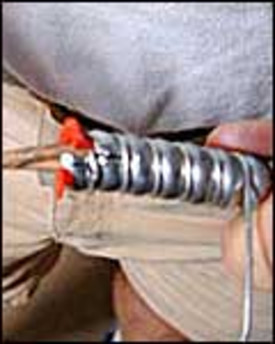Metal clad cable, also known as armored or BX cable, is a flexible metal conduit with a wire bundle, consisting of individually insulated conductors covered by a flexible spiral-wound layer of metal. Most often used for feeder and service power in commercial and multi-story residential applications, the steel or aluminum clad cable is more resistant to damage from puncture or abrasion than non-metallic sheathed cable.
 |
 |
||
|
Step 1 Using a tool called a Roto-Split, the metal sheath of the cable is split to expose the insulated wire. A rotary tool with a cut-off wheel can also be used.
|
Step 2 The conductor wires are usually covered in a paper jacket in addition to the wire’s PVC insulation. |
||
 |
 |
||
Step 3 A plastic bushing is slid over the end of the metal cladding to prevent the cladding’s sharp edged from damaging the conductor wires’ insulation. |
Step 4 The bare ground wire is wrapped around the metal sheathing at each cut end. Insure the bushing protects the wire’s insulation from the cable’s metal sheath. |
||
 |
|||
|
Step 5 The cable is inserted into an electrical box and held in place by a clamp. Final electrical connections can now be made.
|
Editors note:
Local codes vary on the use of metal clad cable in residential applications. Always check with a local building inspector before beginning a new project.
Credit: Renovate Your World




























